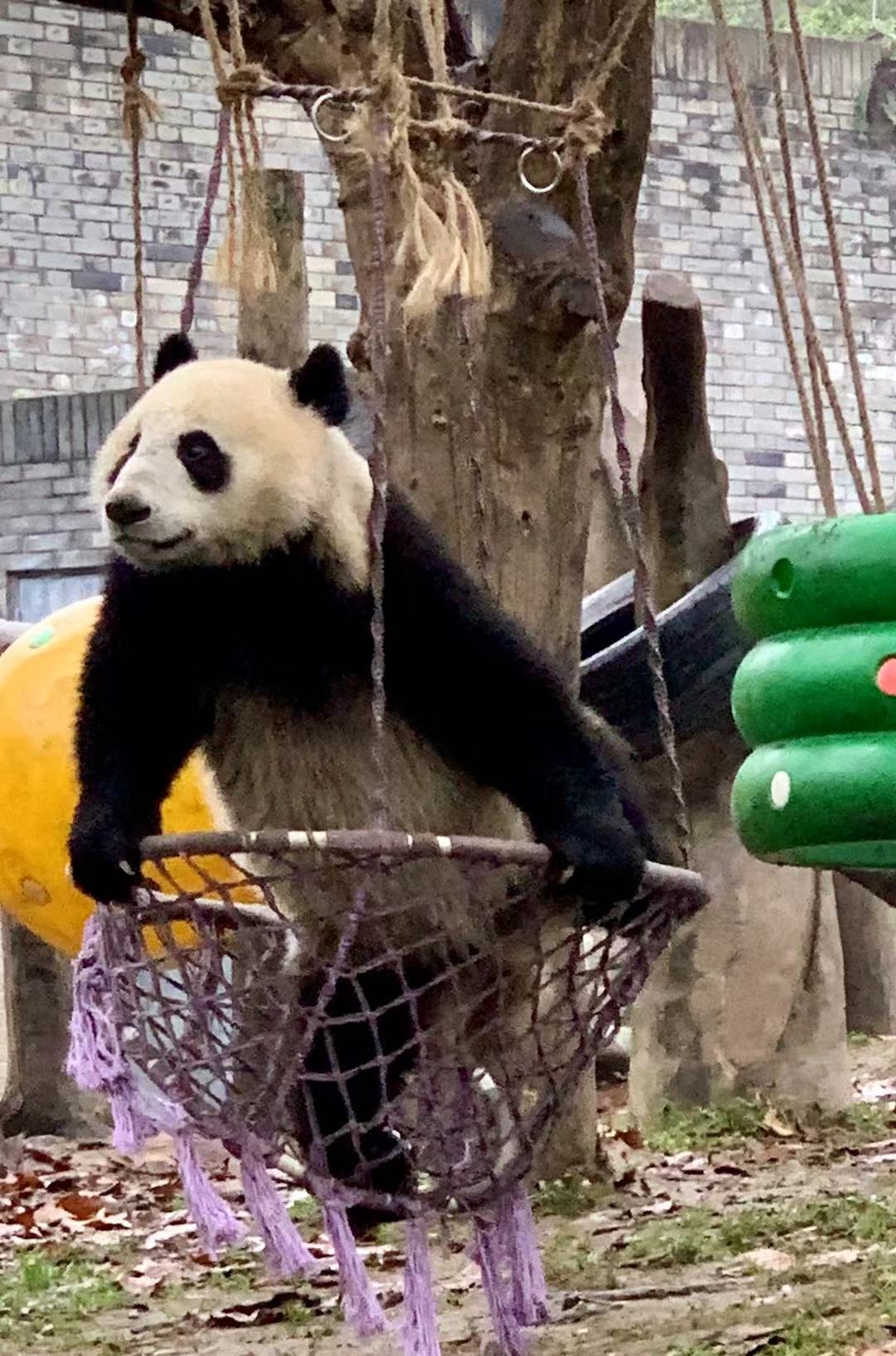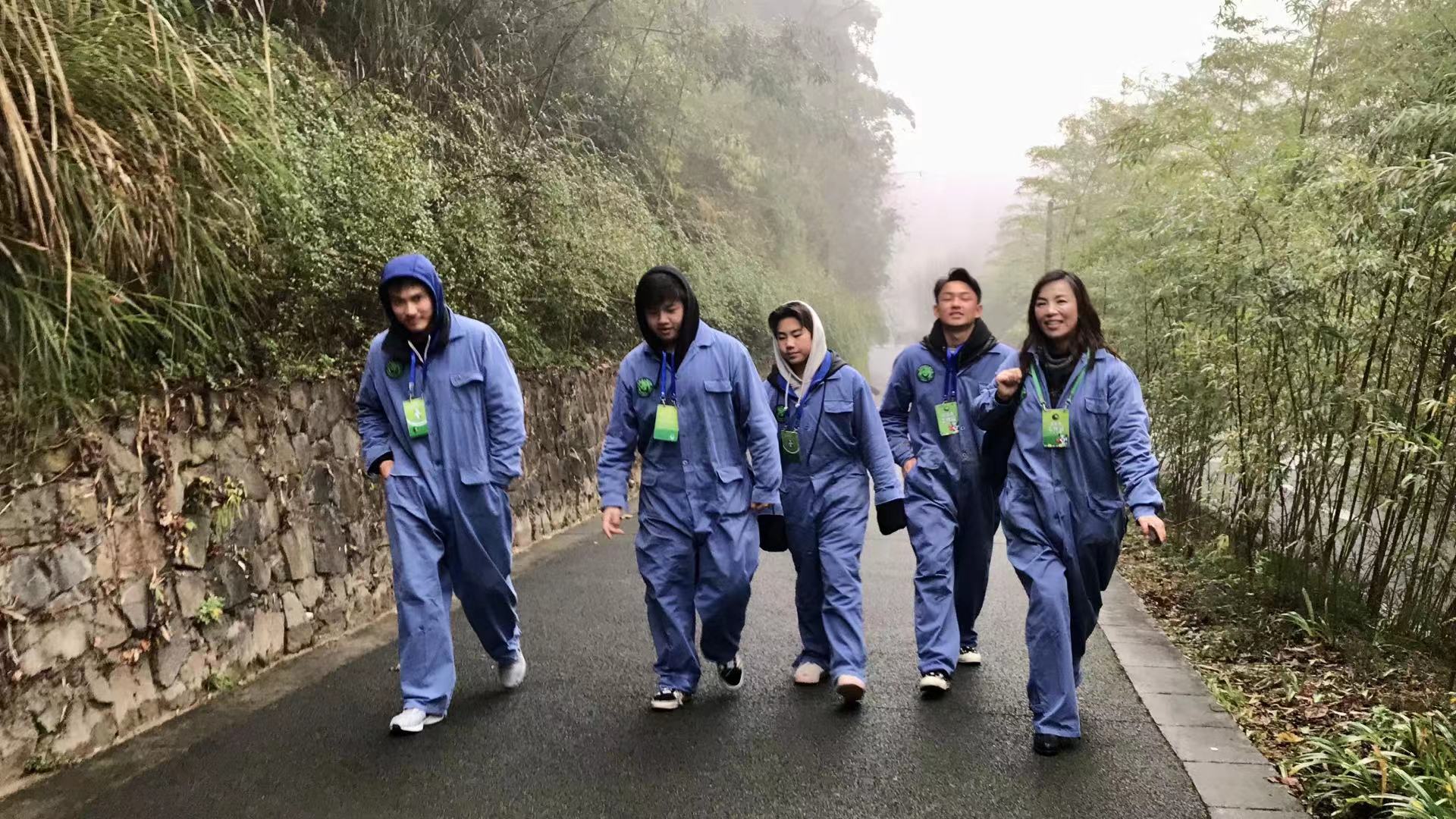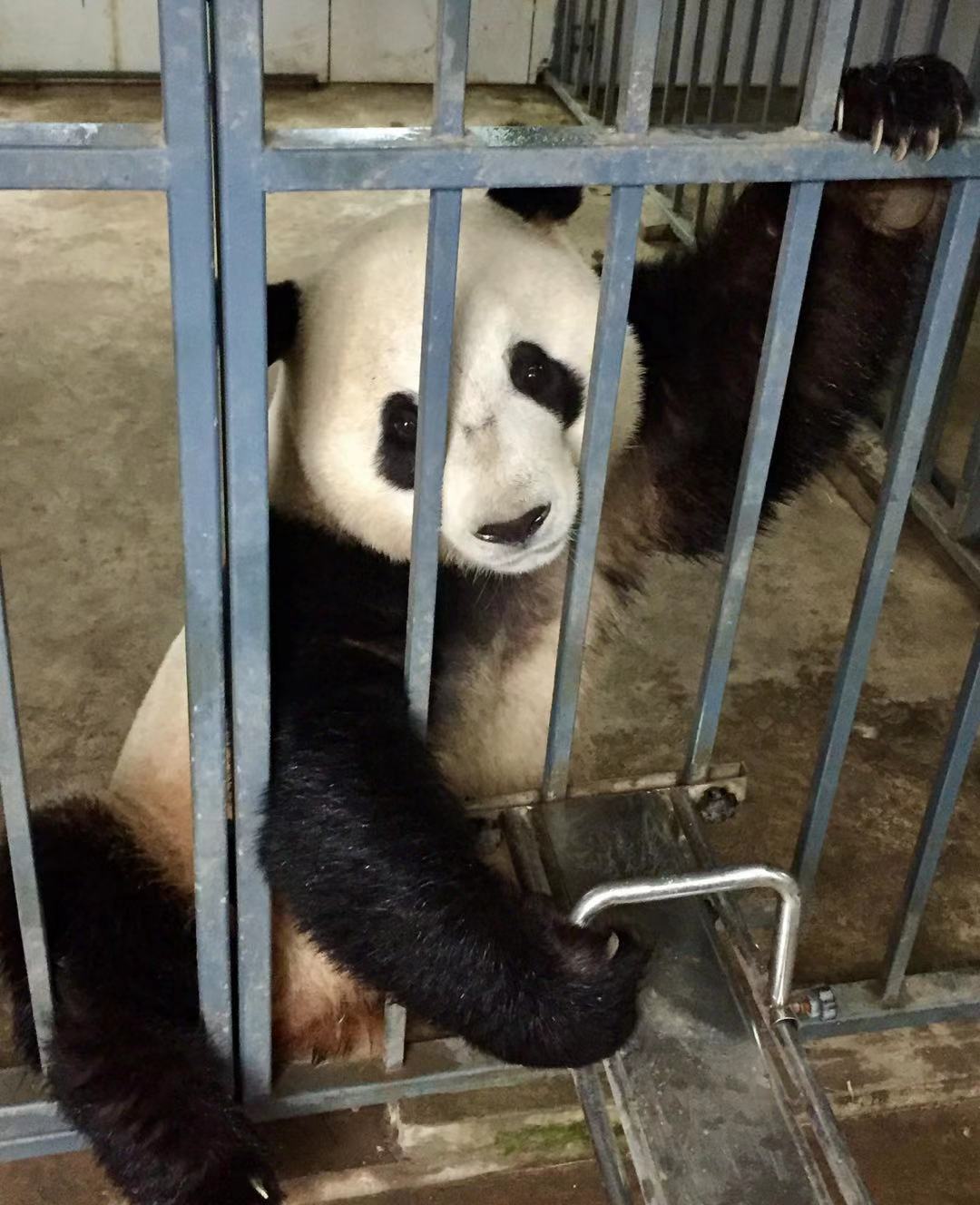Introduction
 Giant Panda (also commonly known as panda) is a special animal to China. Giant panda is also a symbol of China worldwide. With a pair of black patches surrounding its eyes and a fat body, pandas are very easily recognizable. However, not many people have a deep understanding of pandas. In this article, there will be a brief introduction on the two most common knowledge about pandas, including their food and home, followed by my own experience of visiting the Dujiangyan Panda Base of the Giant Panda Research Center situated in Chengdu, China, which is a very valuable experience for me and it’s a place where I have learnt a lot about how people work to improve the living and health of pandas. The article will end with my consideration on the importance of protecting pandas and what we can do on this.
Giant Panda (also commonly known as panda) is a special animal to China. Giant panda is also a symbol of China worldwide. With a pair of black patches surrounding its eyes and a fat body, pandas are very easily recognizable. However, not many people have a deep understanding of pandas. In this article, there will be a brief introduction on the two most common knowledge about pandas, including their food and home, followed by my own experience of visiting the Dujiangyan Panda Base of the Giant Panda Research Center situated in Chengdu, China, which is a very valuable experience for me and it’s a place where I have learnt a lot about how people work to improve the living and health of pandas. The article will end with my consideration on the importance of protecting pandas and what we can do on this.
Panda’s food
 As most of us may know, bamboo is almost everything that pandas eat. However, pandas also enjoy other food and there’s a small difference between the eating habit of wild pandas and pandas in captivity. For pandas in captivity, staff members may fee them with bamboos, fruits, eggs or honey. Considering the health of the pandas, staff members may also develop some special food that contains certain nutrients. For wild pandas, they may also eat other grasses or even meat (usually dead animals), though this is not usual. Pandas spend almost 14 hours eating every day and each panda can consume up to 39 kilograms of food each day, which is the equivalent of 20 hamburgers.
As most of us may know, bamboo is almost everything that pandas eat. However, pandas also enjoy other food and there’s a small difference between the eating habit of wild pandas and pandas in captivity. For pandas in captivity, staff members may fee them with bamboos, fruits, eggs or honey. Considering the health of the pandas, staff members may also develop some special food that contains certain nutrients. For wild pandas, they may also eat other grasses or even meat (usually dead animals), though this is not usual. Pandas spend almost 14 hours eating every day and each panda can consume up to 39 kilograms of food each day, which is the equivalent of 20 hamburgers.
Panda’s home
Most wild pandas live in the southwestern part of China, including Sichuan, Gansu and Shanxi. Because of the need to find a large amount of bamboo or other grass for consumption, they live in bamboo forests situated at 1,200 to 3,400 meters above sea level where the environment is moist. These places are lush with enough resources of food and water for pandas. Most importantly, these places are hidden, which provide protection for pandas from predators. Most pandas prefer to live alone, unless they are in estrus.
Current situation for pandas
 We can always see pandas in zoos or in research centers. Although pandas are native to China, China has gifted or lease pandas to foreign countries throughout the years, such as Belgium, Britain, France, United States and Japan. In history, most of the leases of pandas are for the purpose of bring income to the zoos in foreign countries, because the adorable appearance of panda always attracts a lot of local people to visit them. However, recently, when China lease pandas to other countries, it aims to corporate with those countries for the purpose of research and breeding of pandas. Pandas are actually in a vulnerable situation caused by many factors. For example, killing by human beings, occupation of their habitats by humans, the damage of their habitats by humans and the low mating rate of pandas in captivity. Therefore, there are only around 1,800 wild pandas. By the end of 2018, there are only approximately 548 pandas in captivity.
We can always see pandas in zoos or in research centers. Although pandas are native to China, China has gifted or lease pandas to foreign countries throughout the years, such as Belgium, Britain, France, United States and Japan. In history, most of the leases of pandas are for the purpose of bring income to the zoos in foreign countries, because the adorable appearance of panda always attracts a lot of local people to visit them. However, recently, when China lease pandas to other countries, it aims to corporate with those countries for the purpose of research and breeding of pandas. Pandas are actually in a vulnerable situation caused by many factors. For example, killing by human beings, occupation of their habitats by humans, the damage of their habitats by humans and the low mating rate of pandas in captivity. Therefore, there are only around 1,800 wild pandas. By the end of 2018, there are only approximately 548 pandas in captivity.
 Visit to the Dujiangyan Panda Base of the Giant Panda Research Center in 2008, after the Wenchuan Earthquake, the original giant panda research center located at Wolong was destroyed. Therefore, several giant panda research centers were built in different parts of Sichuan, including centers in Ya’an and Dujiangyan. Among these research centers, I chose to visit the one in Dujiangyan. Understanding the importance of putting efforts into the protection of the cute and precious pandas in China, I visited the center twice, in December 2018 and December 2019. These two visits have brought me valuable experiences. I have done volunteer service at the center and investigation on the lives of pandas. Throughout the whole process, I gained brief knowledge on pandas. In the second visit, I gained a deeper understanding of pandas. I observed the dejection of pandas and analyzed the effect of foods, on panda’s growth and reproduction. Apart from these visits, I also conducted three charity fundraisers and donated all the funds to the center.
Visit to the Dujiangyan Panda Base of the Giant Panda Research Center in 2008, after the Wenchuan Earthquake, the original giant panda research center located at Wolong was destroyed. Therefore, several giant panda research centers were built in different parts of Sichuan, including centers in Ya’an and Dujiangyan. Among these research centers, I chose to visit the one in Dujiangyan. Understanding the importance of putting efforts into the protection of the cute and precious pandas in China, I visited the center twice, in December 2018 and December 2019. These two visits have brought me valuable experiences. I have done volunteer service at the center and investigation on the lives of pandas. Throughout the whole process, I gained brief knowledge on pandas. In the second visit, I gained a deeper understanding of pandas. I observed the dejection of pandas and analyzed the effect of foods, on panda’s growth and reproduction. Apart from these visits, I also conducted three charity fundraisers and donated all the funds to the center.
 The Dujiangyan Panda Base of the Giant Panda Research Center was set up in Chengdu, China. It’s a big place for the scientific research on disease prevention and protection of pandas. With a large number of staff members inside the center, it can facilitate the development of technology for the protection of pandas. Furthermore, the center is also the main base for transferring pandas on loan to other countries and the home for baby pandas born in foreign countries. Besides the research, protection and diplomatic purposes, these centers also contribute in the public education works, including opening the center for public visits and offering chance for the public to have close contact with the pandas, learning to take care of them and understanding their lives. In the center, each panda has its own indoor residence connected with an outdoor garden. Apart from these normal residences, there are also sanatoriums for infants or sick pandas so that they can receive better care from the staff members. Young pandas born in overseas countries are returned to China and are also sent to these sanatoriums for observation and special care.
The Dujiangyan Panda Base of the Giant Panda Research Center was set up in Chengdu, China. It’s a big place for the scientific research on disease prevention and protection of pandas. With a large number of staff members inside the center, it can facilitate the development of technology for the protection of pandas. Furthermore, the center is also the main base for transferring pandas on loan to other countries and the home for baby pandas born in foreign countries. Besides the research, protection and diplomatic purposes, these centers also contribute in the public education works, including opening the center for public visits and offering chance for the public to have close contact with the pandas, learning to take care of them and understanding their lives. In the center, each panda has its own indoor residence connected with an outdoor garden. Apart from these normal residences, there are also sanatoriums for infants or sick pandas so that they can receive better care from the staff members. Young pandas born in overseas countries are returned to China and are also sent to these sanatoriums for observation and special care.

 One of the major achievements in the center is that the staff members have developed a supplementary food made of corn, carrots and apples. This supplementary food has improved pandas’ digestion in the way that the excrement is no longer bamboos, but in a muddy shape. This shows that after eating the supplementary food, pandas get a better digestion system that allows them to digest most of the bamboos they eat. Therefore, the panda’s weights are improved. I plan to take more visits to these research centers in the future, wishing to see the improvements our contributions make to pandas. Next time when I visit to the centers, it would be a good time to focus on the return of pandas in captivity to nature and how they adapt to living as wild pandas.
One of the major achievements in the center is that the staff members have developed a supplementary food made of corn, carrots and apples. This supplementary food has improved pandas’ digestion in the way that the excrement is no longer bamboos, but in a muddy shape. This shows that after eating the supplementary food, pandas get a better digestion system that allows them to digest most of the bamboos they eat. Therefore, the panda’s weights are improved. I plan to take more visits to these research centers in the future, wishing to see the improvements our contributions make to pandas. Next time when I visit to the centers, it would be a good time to focus on the return of pandas in captivity to nature and how they adapt to living as wild pandas.
Impression
 After experiencing the living environment of pandas in the center and learning about how staff members offer care for the pandas through volunteer works and surveys, I can really see how hard the Chinese government is trying to protect this cute animal. Back to the 1980s, people thought catching wild pandas and keeping them in a cage at a research center was the best way to protect them. However, they neglected the living conditions,making most of the research centers became a permanent jail for pandas. There was no effective scientific research on the living habit of pandas, making those research centers a useless place for pandas. However, this situation has gradually improved. There weas legislation prohibiting individuals from owning guns and prohibiting the felling of trees, which secured the living environment for wild pandas. Then, the government started to put effort into panda protection. With the help of technology, more ways were invented to improve the health and breeding of pandas. Under diplomatic policies, China later started to lend pandas to overseas countries so that they can work together to find out ways to take better care of them.
After experiencing the living environment of pandas in the center and learning about how staff members offer care for the pandas through volunteer works and surveys, I can really see how hard the Chinese government is trying to protect this cute animal. Back to the 1980s, people thought catching wild pandas and keeping them in a cage at a research center was the best way to protect them. However, they neglected the living conditions,making most of the research centers became a permanent jail for pandas. There was no effective scientific research on the living habit of pandas, making those research centers a useless place for pandas. However, this situation has gradually improved. There weas legislation prohibiting individuals from owning guns and prohibiting the felling of trees, which secured the living environment for wild pandas. Then, the government started to put effort into panda protection. With the help of technology, more ways were invented to improve the health and breeding of pandas. Under diplomatic policies, China later started to lend pandas to overseas countries so that they can work together to find out ways to take better care of them.
People have said pandas seem to be useless and there’s no reason to protect them in such ways. Christopher Gary Packham, an English naturalist and photographer, said that people spent millions of dollars into panda protection, but there’s no point for keeping pandas in captivity because there is a lack of habitat for them to live in after they are released into nature. However, I don’t really agree with such opinion. I believe we have to protect giant pandas because it’s us who made the pandas become vulnerable and we now have the ability to save them. Pandas are important for spreading bamboo seeds in forests so that more bamboo can grow. With forests full of trees and bamboo, they become suitable habitats for other species like birds and other wildlife. Pandas are also unique to China and are a precious species. In a broader view, pandas are symbolic of China. By studying pandas in research centers, we can investigate how to increase the breeding rate of pandas and it’s an important way to develop medicines to treat sick pandas. According to the International Union for Conservation of Nature, the giant panda was identified as ‘vulnerable’ instead of ‘endangered’, which was a great achievement thanks to the efforts of China and overseas countries.
 We are moving forward in the path of protecting pandas, but this is not the end. Traditional threats like hunting have decreased, but other threats like tourism and industrial construction continue to exist. The World Wildlife Fund (WWF) has stated its 2015-2025 giant panda conservation strategy, which sets out the plans for protecting pandas in these period with a main focus on improving the habitat for pandas and encourage corporation between the WWF and governments around the world to ensure the surviving of wild pandas while not causing damage to local communities. With further development of the modern society in the future, it’s difficult for these threats to pandas to disappear. Therefore, continuous efforts are still needed for conservation of pandas in the future.
We are moving forward in the path of protecting pandas, but this is not the end. Traditional threats like hunting have decreased, but other threats like tourism and industrial construction continue to exist. The World Wildlife Fund (WWF) has stated its 2015-2025 giant panda conservation strategy, which sets out the plans for protecting pandas in these period with a main focus on improving the habitat for pandas and encourage corporation between the WWF and governments around the world to ensure the surviving of wild pandas while not causing damage to local communities. With further development of the modern society in the future, it’s difficult for these threats to pandas to disappear. Therefore, continuous efforts are still needed for conservation of pandas in the future.
 As an individual, there’s also a lot we can do. For example, we can tell our friend or family members about the importance of protecting pandas, we can participate in volunteering activities organized by institutions like panda research centers or theme parks to take care of pandas. We can also generate our own articles after conducting researches and investigations on ways to protect pandas and explain to people some current problems faced by pandas. These are small steps, but they would become a large step if every individual take part in it and offer our help for pandas. Hopefully in the near future pandas are no longer identified as ‘vulnerable’.
As an individual, there’s also a lot we can do. For example, we can tell our friend or family members about the importance of protecting pandas, we can participate in volunteering activities organized by institutions like panda research centers or theme parks to take care of pandas. We can also generate our own articles after conducting researches and investigations on ways to protect pandas and explain to people some current problems faced by pandas. These are small steps, but they would become a large step if every individual take part in it and offer our help for pandas. Hopefully in the near future pandas are no longer identified as ‘vulnerable’.
Bibliography
1. Ocean Park Hong Kong, 2019, Giant Panda.
2. Tang Ying, 2018, 2018 New Data on Giant Panda Released! Number of Worldwide Captive Panda Reached 548, Chinese Economic Website.
3. Zhang Qiaofu, 2015, Establishment of the China Giant Panda Research Center, Xinhua Net.
4. The Telegraph, 2009, Chris Packham: ‘Giant pandas should be allowed to die out’.
5. Swaisgood, R., Wang, D. & Wei, F, 2016, The IUCN Red List of Threatened Species 2016, IUCN Global Species Programme Red List Unit.
6. World Wildlife Fund, 2019, Looking Ahead.

